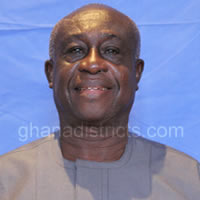Establishment, Location and Size
The Bosomtwe District Assembly is one of the 43 districts in the Ashanti Region. It was carved out from the then Bosomtwe-Atwima-Kwanwoma District by Legislative Instrument, LI. 1922 of 2007 The Bosomtwe District, is located at the central part of the Ashanti Region and lies within latitudes 6° 24 South and 6° 43’ North and longitudes 1° 15’ East and 1° 46’ West. It is bounded on the north by Asokwa Municipal Assembly, on the east by Ejisu Municipal, on the south by Bekwai Municipal and Bosome - Freho District, and on the west by Atwima - Kwanwoma District.
The district has a land size of about 422.5 sq. km. It is the eleventh largest district in the Ashanti Region. The Bosomtwe District has 67 communities. Kuntanse is the district capital. The District is sub-divided into three area councils namely, Jachie, Kuntanase and Boneso. Figures 1.6 and Figure 1.7 show Bosomtwe District in the national and regional context respectively. Figure 1.8 also depicts the map of the District showing the sixty-seven communities.
Relief and Drainage
With the exception of the Lake that has an outer ridge that maintains a constant distance of 10 km from the center of the lake and stands at an elevation of 50m to 80m, the rest of the District cannot boast of any unique topographical features. The drainage pattern of Bosomtwe District is dendritic. The rivers flow in a north- south direction. Around Lake Bosomtwe, there is an internal drainage where the streams flow from surrounding highlands into the lake. The rivers are perennial. They also form a dense network due to the double maxima rainfall regime. Notable rivers in the District are rivers Oda, Butu, Siso, Supan and Adanbanwe.
Climatic Condition
The District falls within the equatorial zone with a rainfall regime typical of the moist semi- deciduous forest zone of the country. There are two well- defined rainfall seasons. The main season occurs from March to July with a peak in June. The minor season starts from September to November with a peak in October. August is usually cool and dry. The main dry season occurs in December to March during which the desiccating harmattan winds blow over the area.
Temperature
Temperature of the area seems to be uniformly- high and throughout the year with a mean average of around 24ºC. The highest mean temperature occurs just before the major wet season in February as observed in Kumasi- ( 27.8ºC). The mean minimum occurs during the minor wet season.
Vegetation
The vegetation of the entire district is the semi deciduous forest type. It is characterized by plant species of the Celtis-Triplochetol Association. However, due to extensive and repeated farming activities in the past, the original vegetation has been degraded to mosaic of secondary, thicket and for re-growth and various abandoned farms with relics of food crops and vegetables. The cultivation of several food crops and cocoa as well as animal rearing have been major agricultural activities in the district.
The secondary forest is characterized by close upper canopy at height of about 9m with a number of growing soft wooded trees and few hard woods. It has less open undergrowth of spiny shrubs and climbers. The major tree species are Terminalia Spp Funtumia Spp, Ceiba pentandra, BambaxSpp, Archonia Spp, Corfolia, Celti mildrbraedii, Triplochiton scleroxylan,Elaesis guineesis, Tremasenegalensis And Ficus Spp. Thicket corresponds to forest areas of about five years with relatively impenetrable mass of shrubs, climbers, coppice shoots and young trees.
Fauna
Mammals
Five mammal taxonomic groups, representing 17 Families, 26 Genera, and 29 Species have been confirmed during a baseline survey in 2013. Rodents were the most widespread and diverse family and accounted for 38% of all mammals compiled. Giant rats and grass-cutters represented the most abundant species. Brush-tailed porcupines and forest squirrels were however restricted to the proposed core areas, in abundance and distribution. Bats were the least number of species, representing about 10% of the total mammals. Most of the mammal species were forest dependant and thrived in forest habitat.
Birds
Twenty-nine (29) bird species, belonging to 25 genera and 16 Families were recorded in the study area. Fourteen percent (14%) of the species recorded belonged to the Family Accipitridae. Phasianidae,Columbidae and Ploceidae were represented by 10% each. Rare families included Ardeidae, Strigidae, Caprimulgidae, Pycnonotiae, Meropidae, Capitonidae, Hirundinidae and Dicruridae with a record of 3% species each. Village weaver, lesser striped swallow, common bulbul, brownnight jar, Senegal coucal, red-chested cuckoo, green turaco, green fruit pigeon and black kite were also recorded during the base line studies.
Butterflies
Nineteen (19) species, belonging to 6 Genera were identified. Most of the specimen collected and recorded belonged to the Families Limenitiinae (32%) and Satyrinae (32%). Another Family included Charaxinae (26%).
Geology/ Soils
The district is underlain by Precambrian rocks of the Birimian and Tarkwaian formations. They are associated with granites and metamorphosed sediments of phyllites and schilts.The Soil type in the District has developed over a wide range of highly weathered parent materials such as granite, Tarkwaian and Birimian rocks.
Soils and Agricultural Land Use in the District
The district has six main soil types that are described as follows:-
Soil developed over granite and associated rocks. i.e.
Kumasi-Offin compound Association
Bomso-Offin Compound Association
Soil developed over the upper and lower Birimian Rocks
Bekwai-Oda Compound Association
Bekwai-Akomadan-Oda Compound Association
Kobeda-Bechem-Webenso-Oda Compound Association
Atukrom-AsikumaAssociation.
The Kumasi-Offin and Bomso-Offin Compound Associations have similar characteristics. They are well drained and made of quartz gravels and iron-stone nodules in the sub-soil. They are mostly found in the western end and of the middle belt of the district respectively. They support both cash and food crops such as coffee, cocoa, oil palm, citrus, vegetables, maize among others.
The Bekwai-Oda, Bekwai-Akomadan-Oda and Kobeda-Bechiem-Sebenso-Oda Compound Association also have similar characteristics. The associations are found mostly in the western, north-eastern and eastern parts of the district respectively. These soils are moderately well-drained and support cash crops, legumes and food crops.
The Atukrom-Asikuma Association is well drained in some parts. The soil is mostly found in the eastern part of Lake Bosomtwe and supports food and tree crops as well as vegetable and sugar-cane production.
The soil types in the district have been found to be ideal for the cultivation of cash crops and indigenous food crops. These soils developed over a wide range of highly weathered parent materials including granite, Trakwaian and Birimian rocks. They are more richly supplied with nutrients.
Implications of the Physical and Natural Environment for development
The implications of the physical and natural environment for development are as follows;
The rivers and streams in the district cannot be relied upon for any meaningful irrigation agriculture due to their seasonal nature.
The Lake is an important tourist destination in the country
The bi-modal rainfall encourages the cultivation and harvesting of some crops twice in the major and minor seasons eg. Maize, vegetables
The soils in the district are generally good for agriculture. The soils support both cash crops like cocoa and food crops such as plantain, cassava etc.
The mineral deposits like sand, stones support the building industry
The presence of gold deposit has encouraged illegal mining popularly known as “galamsey”
Exploitation of the mineral deposits like sand and stone deposits will generate employment to the unemployed youth and also improve the Assembly’s IGF
The proximity to Kumasi allows the district to access high educational institutions to provide human and research capital for businesses, including, KNUST, Forest Research Institute,, Building and Road Research
Bio-diversity, Green Economy and Environment
The district is endowed with immense natural resources in the form of arable land and forests. The exploitation of arable land in the district to meet socio-economic needs of the people has adversely affected the fragile environment. Uncontrolled bush burning, particularly in the smaller settlements is fast threatening the bio-diversity, thus putting the fertility of the soil at risk and reducing potential resources for future generations as the vegetation is fast degenerating into secondary forest and derived savannah. Large scale clearing of watersheds, particularly around the major communities like Esereso, Feyiase, Aputuogya, Jachie, Pramso and the lake front communities is one of the major causes of dwindling rainfall and consequent effect on acute water supply, especially during the dry season. Logging in the district is another serious threat to the environment. The destruction of farm lands coupled with the removal of both larger and smaller trees has also destroyed the forest eco-system. Sand winning is also extensively done in the district. The destructions caused by this activity to the environment are extensive
Economically, the alarming rate at which bio-diversity is lost calls for action, to arrest the situation for the present and the future generations to benefit.
The phenomenon of environmental degradation is now a serious problem in the District. Besides, the use of improper methods of farming which exposed the soils to erosion, people have continued to harvest forest resources indiscriminately thus degrading the environment. The problem associated with the soil types is that because of the torrential rains which are experienced in this area, the soils are easily leached of their nutrients. Soil erosion over the mountain slopes is also a problem since the vegetation cover has to be removed before crops are cultivated. Hence, infertility of the soil is gradually becoming a serious problem.
A Green Economy is a clean, environmentally friendly economy that promotes health, wealth and well-being. A Green Economy is dependent on sustainable development-which means growing our economies in ways that benefit, not sacrifice, social justice and equity as well as the environment. The idea is to serve the needs of the present without threatening the quality of life of future generations. Building a Green Economy is not about throwing out the old system and starting from the scratch, it’s about making choices according to the full cost-not just the financial cost-of any and all activities.
Key development Issues in Climate Variability and Change
Limited human resource capacity in Climate Change issues
Limited awareness of climate change and its impacts
Unsustainable exploitation of natural resources
Inadequate financial resources
Inadequate early warning systems
Degraded urban waterfronts with potential for redevelopment
Inadequate infrastructure to cope with the impacts of climate change
To integrate climate change into the district’s Composite Program of Action the following climate sensitive Sub- Programmes have been selected and they:
Agriculture and Rural Development
Health Delivery
Water and Sanitation
Roads and Transport Services
Fisheries
Date Created : 11/18/2017 3:00:49 AM




